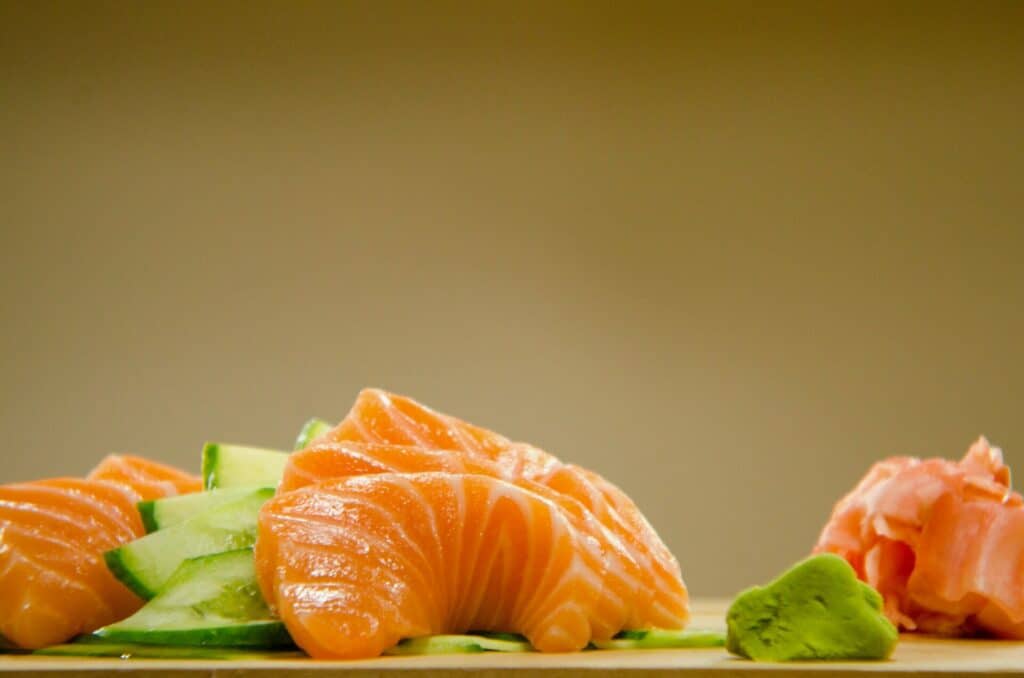Japanese food lovers often can’t decide between ordering sushi and sashimi because they are equally delicious. But for all those who are unsure if these two food names are interchangeable, let’s see does sashimi have rice.
Does sashimi have rice? No, sashimi does not have rice. It is a meal made out of raw fish that has been finely sliced. There’s no rice, no added spices, only the fresh and high-quality fish. Sashimi is normally served plain or over a bed of shredded Japanese radishes called daikon.


The term sashimi literally means “cut body” or “pierced body” in Japanese. Sashimi as a meal can be referred to many kinds of meat – from raw beef and chicken to seafood, but raw fish is probably the most popular for consumption this way.
Does Sashimi Have Rice?
Sashimi is a popular Japanese dish made of thinly sliced meat, preferably fish or other seafood. Most typically, it’s made out of some type of salmon or tuna. Adding vinegar rice to raw fish makes the main difference between nigiri, sashimi, and sushi. While sashimi can be served over a bed of daikon (Japanese radishes) and flavored with some soy sauce or wasabi, it does not contain rice, like nigiri and sushi.
Some say that it was inspired by a delicious meal at the Japanese court during the Heian period. The slices of raw fish and vegetables in this dish were seasoned with a vinegar called “namasu.” Others claim it began during the Kamakura era when fishermen sold slices of fish as fast food. Whenever this delicacy emerged in history, we still get to enjoy it today.
What Are the Most Popular Types of Fish for Sashimi?
While sashimi as a dish can be made out of different types of meat, it is typically made out of seafood. These are the most popular types of fish and seafood used in sashimi making:
- Katsuo (Bonito/Skipjack Tuna),
- Sake (Salmon),
- Maguro (Bluefin Tuna),
- Ahi (Yellowfin & Bigeye Tuna),
- Engawa (Halibut),
- Hotate (Scallops),
- Ebi (Sweet Shrimp/Prawns).
How Is This Japanese Delicacy Usually Served?
So, Sashimi is made out of tuna and other different kinds of fish, but how it’s served? While you may have it served on a Japanese-style sushi plate plain or over some ice, it’s usually served with a garnish. It can be daikon radish, kogiko chrysanthemum flower, benitade (red water pepper sprouts,) or shiso perilla herb. The most typical condiments served with sashimi are wasabi horseradish, soy sauce, and occasionally ponzu, soy sauce with a citrusy flavor.
What Does Good Sashimi Taste Like?
So, what does good sashimi taste like? This delicacy tastes like cooked fish but with a different and creamier texture. However, it shouldn’t be slimy because that’s an indication of bad food. If it’s prepared with care and from high-quality fish, some would say that it tastes like heaven. Other than that, it will mostly depend on the type of fish you’ve chosen. The fish flavor is mild, while the texture is rich, with a smooth overall taste.

Let’s Compare – Nigiri vs. Sushi vs. Sashimi
If you are not very well versed in recognizing different types of raw seafood, you should know a bit about the three most popular choices – nigiri, sushi, and sashimi. While nigiri is the most common type of sushi and is served with vinegar rice, sashimi doesn’t have any rice or other additional ingredients. But let’s see the key differences between these three delicacies.
| Nigiri | Sushi | Sashimi |
| Has vinegar rice | Has vinegar in sushi rice | Does not have rice |
| Doesn’t have nori | Usually contains Nori (seaweed) | Doesn’t have nori |
| Doesn’t contain additional ingredients | Modern variants contain additional ingredients, like avocado, cucumbers and the like | Doesn’t contain additional ingredients |
| Can be flavored with soy sauce and wasabi | Can be flavored with soy sauce and wasabi | Can be flavored with soy sauce and wasabi |
You can find delicious pre-prepared sushi in Kroger, while for a good sashimi bite, you should pay a visit to the nearest Japanese restaurant.
Sashimi Is One of the Best Ways to Enjoy Raw Food Delicacies
Raw, uncooked fish typically served in thin slices as sashimi is something that you should experience at least once. Served with wasabi or soy sauce, it’s equally chewy and creamy in your mouth and makes a great mix of tastes that emphasize one another. If you’re not sure you will like this dish, you can combine your order with some makizushi and other types of sushi, along with some delicious Japanese Miso soup.